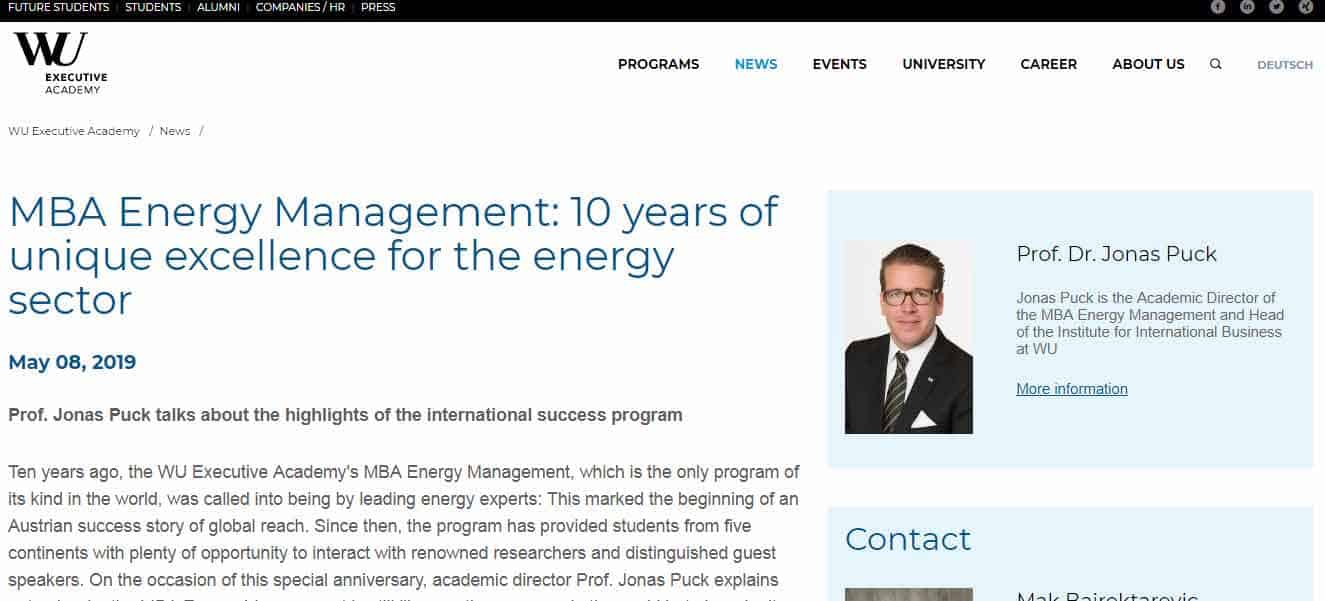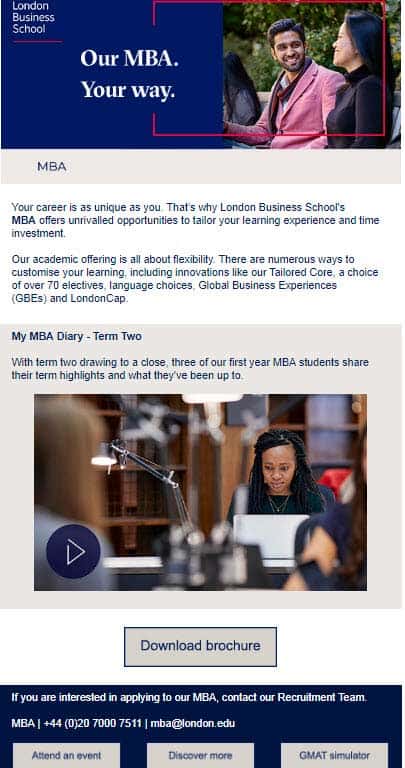
Digital Marketing for Business Schools has always been one of the education sector’s most unique and dynamic areas. Serving a highly ambitious, intelligent, and hard-working base, these institutions provide students worldwide with prestigious qualifications as a gateway to lucrative top-level career opportunities.
With its emphasis on relationship building, value, and informativeness over traditional ‘hard-selling’ tactics, digital marketing should be a natural fit for this space. Yet, while most business schools engage in online recruitment activities, there is an abiding sense across the sector that many could be making more of the potential of digital channels to maximize visibility and impact.
If your institution could get more from its digital marketing initiatives, there is no better time to re-examine your efforts now.

Why is Digital Marketing for Business Schools Needed?
Competition among business schools has never been more intense. For a start, today’s professionals and aspiring professionals alike are increasingly mobile. Once schools dealt with a narrow field of prospects and competitors in their region (with a small cohort of international applicants), they are now faced with a vast global marketplace.
This is reflected in recent application trends, with a 2018 Graduate Management Admissions Council survey showing more regional variation in application rates across different countries. Compounding this, the sheer amount of choice is increasing constantly, with quality schools offering an increasingly diverse array of courses to suit prospects’ needs.
It isn’t just other business schools that your institution has to compete against; it’s other opportunities. In recent years, more and more young professionals have questioned the overall value of qualifications to further their careers, as graduates have found their job prospects more limited than they once were. As MBA graduate Daianna Karaian commented in an article for The Economist, “These days, questioning the value of a business degree is one of the few growth industries.”
While this skepticism about the value of education is not unique to business schools, it is becoming increasingly challenging to convince prospects that pursuing a business degree is the best path to reaching their professional goals.
Look at The Graduate Management Admissions Council’s Survey

Shorter professional certifications, MOOCs, and corporate training programs are also gaining traction as alternate routes to success.
This means that business schools today face a more discerning audience than ever. Simply put, students want a business education option that will perfectly fit their needs and provide a dependable path toward helping them advance their careers, and they are willing and able to go further than ever before to get it.
Reaching such a demanding market is difficult, but digital marketing can provide avenues to make it happen. Through targeted and strategic initiatives across various channels, your school can position itself at the forefront of this busy marketplace and engage prospects at every stage of the enrollment journey to convince them that your programs are the right choice for their needs.
Defining Personas for Your Business School
The first step to recruiting business school students online is ensuring you have developed well-researched, accurate personas. Depending on what your school is offering, you may need to look at various digital marketing ideas for schools to cater to specific segments of your audience and their unique needs.
For example, your school might find the motivations and goals of international students are very different from your domestic student base. For instance, they may be concerned about the cost of living in your city or want to know more about post-graduation visa regulations in your country.
On the other hand, you may be specifically looking to target local students for a particular program. For instance, a part-time MBA with an evening or weekend schedule might be best pitched toward professionals working in your city or region. Segmenting your personas will allow you to develop separate but complementary digital marketing initiatives that consider and speak to each group.
Example: An excerpt from a business school persona developed for local applicants.

Looking at Personas
Age differences, professional experience, and income levels are other examples of disparities within your target audiences that may require segmenting them into separate personas. If you offer several different programs, you may also find that the potential pool of applicants for each is widely different.
Another persona that is arguably unique for business schools to cater to is employers. Many organizations will offer funding to employees to pursue high-level qualifications like MBAs and business master’s degrees.
Even if this isn’t the case, an employer may offer prospective student support in other ways, such as by providing them with time off to pursue their studies.
Even if you never deal directly with inquiries from these organizations, your student recruitment campaigns still need to address their needs and communicate how your students will use the skills and knowledge they gain from your courses in their day-to-day work, becoming more of an asset to their employers.
Through the typical prospects that personas provide, you can develop key messaging for your school or specific programs that speak clearly to your target audience and can then inform every aspect of your digital marketing initiatives.
Positioning Your Business School as a Thought Leader Through Content Marketing
Content development is one of the most important aspects of modern digital marketing. Across all sectors, consumers increasingly favour organizations that eschew traditional selling tactics and instead focus on providing them with valuable, relevant expertise that helps to address their problems.
This shift in audience needs has caused many organizations to emphasize building trust through well-researched, informative online content, such as blogs, videos, and infographics.
More than most, business schools are ideally placed to thrive in this environment. As Toby Roe of EFMD Global Network highlighted in a recent article, academic experts tend to be seen as highly trusted sources of information. This credibility and a respected business school’s prestige and name recognition could allow institutions to establish themselves as leading online authorities.
This, unfortunately, is where some business schools tend to fall. While they publish content regularly, it tends to have more of a ‘news’ focus, with most posts being short articles offering quick updates from the school. As helpful as this kind of content can be for your school community, it doesn’t necessarily have the persuasive power that more in-depth, strategically thought-out posts can generate engagement and convince prospects that your school is the right choice. Long-form content also tends to be favoured by search engines, making it easier to rank in targeted searches.
Positioning your school as a thought leader can be done through a mixture of strategically targeted content marketing initiatives. For instance, content highlighting or discussing the latest trends and developments in the business sphere can be a great way to capture the candidates’ attention that many business schools seek to engage.
Here are Examples
Hult International Business School makes thought leadership a huge focus of its blog output. Posts focusing on topical subjects or new developments like the one below can help capture prospective students’ imagination.

You can also draw on the talents of your faculty and alumni. Creating profiles, interviews, and soliciting guest blogs can all be excellent ways to elevate your content to the next level while showcasing the expertise that your courses and programs will offer prospects.
Example: WU Executive Academy often leverages its expert faculty to produce content. In this article, Professor Jonas Puck talks in great detail about the history and successes of its MBA in Energy Management program.

The key, as always, is for your school to remember who its audience is. Prospective business school candidates tend to be highly educated and intelligent and will expect content that offers real depth and insight.
If you can accomplish that, your web presence will serve as evidence of the level of knowledge that your school can offer prospects and help to convince them that a business education is the right avenue to reach their goals.
Driving Student Inquiries and Applications on Your Website
Producing quality content will help to drive traffic to your website, but it is equally important that your school is well-positioned to translate that traffic into inquiries and applications.
Simply put, all the information prospects might need before applying should be readily available – and easy to find – on your website. Additionally, any pages you have that might serve as touchpoints for prospective students researching your courses and programs should push them toward conversion through carefully placed inquiry forms, CTAs, links, and offers.
A good place to start is your homepage. Your homepage will be the primary landing page for the vast majority of your leads, and it needs to position your school and its programs in a way that will grab your audience’s attention. Your school’s key messages and unique selling points should be communicated immediately and arrestingly.
Here are Examples
The homepage of HEC Paris is very well-designed. It immediately outlines the school’s USP and offers numerous CTAs for visitors to move forward. The nicest touch is perhaps the three options under the ‘Find the best program for you’ section, which offers a path for each of the school’s main target personas: students, professionals, and employers.

Your homepage should also provide easy navigation to other important pages on your site. This could include your program pages and pages related to financing, your application process, student life, facilities, and anything else likely to appeal to them. These pages must also be rich in content and information, including CTAs that naturally prompt prospects to take the next steps.
Example: The Rotman School of Management has a dedicated page on its website offering financing advice for potential MBA applicants. CTAs on the right-hand side of the page prompt prospects to move towards further inquiries and applications once they have the information they need.

In short, rather than simply offering different information scattered across various pages, your entire website should have a logical flow that drives leads down the funnel toward conversion.
Finding Quality Business School Leads on Social Media
Social media can also offer various avenues to improve your visibility, amplify your web content, drive traffic to your site, and engage with prospects directly.
Of all the popular social networks, LinkedIn is perhaps the one that holds the most desirable return for business schools. The site hosts a desirable audience of young but experienced professionals across various industries. Even more promisingly, data from the Pew Research Centre indicates that 49% of LinkedIn users earn over USD$75,000 per year, meaning they have the financial means to pursue a high-level business school qualification.
Another crucial advantage of promoting your school on LinkedIn is the mindset of users. Those who frequent the site are highly motivated and ambitious, making them prime candidates for qualifications like MBAs. Furthermore, they tend to log on with a purpose, specifically seeking knowledge and insights to better themselves professionally rather than casually browsing or connecting with family and friends as they might on other social networks. This makes any efforts from your school to engage with them somewhat more likely to resonate.
Your school can use many different tactics to generate engagement on LinkedIn. For instance, you could post links to blogs or articles on your website targeting those with a professional mindset or share interesting studies, facts, and figures from elsewhere. It’s also the ideal platform to highlight the successes of your alumni, many of whom may be very active on the site themselves.
Here are Examples
Rutgers University shared this success story about a business school graduate who went on to a successful career in marketing.

As effective as focusing some of your efforts on LinkedIn can be, that isn’t to say you should underestimate the value of other social media sites. Twitter, for instance, is an extremely active and vibrant forum that many young professionals frequent to keep up with the latest news and trends in their sector. It can be a great way for business schools to encourage conversation amongst their school community.
Example: The Rotterdam School of Management regularly shares topical content on Twitter.

Facebook and Instagram, on the other hand, arguably hold even more importance due to the sheer size of their audiences. Both platforms can be good places to deliver more informal, casual content, making your school more accessible and relatable to prospects. However, there is also room for more serious content that can drive visits to your website and conversions more effectively. The diversity of both sites’ audiences means there’s room for almost everything.
Supplementing Your School’s Organic Digital Marketing Efforts with Paid Advertising
While organic digital marketing efforts can gain your school some traction, having some budget set aside for paid advertising is essential in today’s online environment. This is especially true on social media, as the organic reach of many brands on networks like Facebook has been severely limited in recent years.
Social advertising also offers some advantages, making it desirable and necessary. The targeting options on different networks allow you to accurately pinpoint audiences that are in line with your student personas, making it easier to ensure that you reach qualified, interested prospects.
Understanding Facebook, LinkedIn, and Twitter
All three platforms allow you to build audiences for your ad campaigns based on key attributes like age, location, gender, education level, employment information, and interests.
LinkedIn has been particularly fruitful for many business schools worldwide, and the company itself highlights numerous success stories in the sector on its website. For instance, Queen’s School of Business used Sponsored Updates and InMail to increase interest in its ‘thought leadership platform’ QSB Insights and webinars. The campaign achieved an incredible 300% increase in traffic to QSB Insights and a 60% increase in webinar attendance, resulting in an additional 450 leads for their executive MBA program.
Example: Queen’s School of Business ran one of the ads in their LinkedIn campaign.

Facebook Ads is also a great potential conversion channel for business schools, particularly as it offers the potential to advertise on Instagram and Messenger. The platform’s placement options and formats also make it an extremely versatile option.
Paid Advertising is Also Beneficial
Away from social, paid search on Google Ads can also be extremely effective in driving conversions. Because they offer you the potential to target by keyword, you can find prospects actively searching for schools and programs. This makes it an interesting alternative to the demographic-based targeting options on social media.
One disadvantage of advertising for business schools is that competition for desirable keywords and placements can be fierce, which may result in higher bids needed to secure what you want.
For example, advertising on LinkedIn can be more expensive than on other platforms because many B2B marketers and high-end enterprises use it. In contrast, the bids required for many desirable keywords for business schools on Google Ads—such as ‘MBA degree,’ for instance—can be quite high. Nonetheless, strategic planning and targeting can help mitigate the cost to a certain degree.
Ideally, most business schools combine search and social campaigns across several networks. However, your initiatives may be limited by your budget. Carefully evaluating your target audience and what channels they are most likely to be active on will help you distribute your ad spend across the platforms most likely to secure a good return.
Following up on Online Student Inquiries
Digital tools are also becoming increasingly integral to the inquiry follow-up process. At a basic level, creating autoresponder emails to be sent to students at the initial point of inquiry can help create a strong first impression.
Your team should try to make these as rich in detail as possible, offering helpful information rather than just thanking leads for their inquiry or promising a follow-up response soon. You can make this easier by including fields in your forms that allow you to segment leads by program or another relevant parameter at the point of inquiry. This way, you can create different autoresponder templates for different target groups.
Once a lead is in your system, you can also create automated nurturing workflows to maintain contact and stay top of mind with leads while slowly moving them toward enrollment with carefully timed messaging and enticing CTAs. Including complementary content offers, such as links to blogs and videos, can help provide added value to recipients.
Here’s an Example
A lead nurturing mail from London Business School. The message is concise and direct but includes much-added-value content, including a video and the option to download a brochure. Further CTAs at the foot of the mail encourage recipients to apply, discover more, or try out the school’s GMAT simulator.

If possible, you should aim to supplement this with manual contact from your admissions team, either by calling them or encouraging them to book meetings (whether online or in-person) with one of your advisors.
A good marketing automation system will allow you to create workflows with a range of enrollment triggers and ‘if/then branches,’ which can be set to take different actions with different leads depending on their specific activity or circumstances. Your team may even be able to implement lead scoring to prioritize follow-up with more qualified leads. You can create the perfect follow-up process for your school’s needs using these tools.
The Importance of Online Events in Digital Marketing for Business Schools
Information sessions, open houses, and lectures have always been key to business school student recruitment. They serve as key conversion events where prospects can have their most pertinent questions answered and solidify their interest in your school.
In today’s more digital marketplace, online versions of these events can serve the same purpose, with the added value of enabling you to reach a wider audience worldwide. As a result, more and more business schools are investing time in virtual tours, information sessions, and webinars. These events have a high conversion rate and should be promoted extensively across all your digital channels.
Paid advertising can be particularly effective for this. Your school can create short-term campaigns through paid search or social media to drive registrations. Promoting your event in your social media news feeds in the days leading up to it can also help to increase the number of prospects you attract.
Look at These Examples
Alliance Manchester posts details of its webinars on LinkedIn to attract registrants.

You should also use email marketing to reach out to the existing leads in your database in the weeks leading up to an event, as it may be just the push they need to move forward with their application. An initial email can be followed with reminders for those who signed up close to the event and follow-up emails for those who have yet to commit.
Example: A typical email marketing workflow for a webinar. You can automate this process with marketing automation tools.

Following up after an online event is equally important. Your admissions team can send automated emails to those who attended and those who registered but didn’t attend, encouraging them to apply or arrange one-on-one contact with advisors. It would be best if you aimed to do this no more than 24 hours after the event to capitalize on their interest while the session is fresh in their minds.
Measuring Your School’s Digital Marketing Success
While being active across various digital channels is important, it’s equally crucial to measure your efforts’ success continuously. Doing so will help you identify areas for improvement and work to maximize your potential results over time. Fortunately, one of the greatest strengths of digital marketing for business schools is its measurability.
The key is ensuring your efforts are tracked at every stage of the enrollment journey. Google Analytics can measure traffic and lead generation on your website through various channels. At the same time, you can evaluate the success of your paid advertising and social media marketing efforts through platform-specific systems like Facebook Insights and Google Ads.
Once an inquiry has been made, you can monitor your team’s productivity, the success of your follow-up efforts, and application and attrition rates by configuring your CRM and marketing automation reporting. Many of these systems will also offer additional insights into the conversion rates of your landing pages, inquiry forms, CTAs, and other digital marketing components.
It’s important to note that you should not necessarily expect digital marketing to provide a quick fix for your school. While some strategic efforts – particularly in the realm of paid advertising – will provide you with significant short-term gains in inquiries and applications, the majority of your online initiatives will serve more to lay a long-term foundation for future recruitment. By cultivating an active and visible online presence across the web, you are building an infrastructure to attract a steady stream of regular leads for years to come. If your school is willing to put that effort in, the rewards will be well worth it.

FAQ To Consider
Is digital marketing useful for MBA students?
Those who frequent the site are highly motivated and ambitious, making them prime candidates for qualifications like MBAs.
What is digital marketing in business studies?
Reaching such a demanding market is difficult, but digital marketing can provide avenues to make it happen. Through targeted and strategic initiatives across various channels, your school can position itself at the forefront of this busy marketplace and engage prospects at every stage of the enrollment journey to convince them that your programs are the right choice for their needs.





